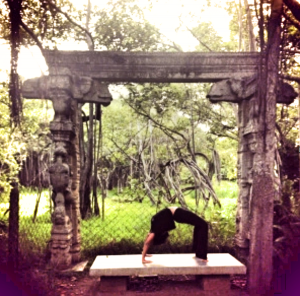“Honoring Transitions” by Priya Krishnan
April 14, 2016
The following is a guest blog post by Priya Krishnan for the Yoga and Body Image Coalition.
I’ve said it before and i’ll say it again: if you can appreciate a waning gibbous, you can appreciate everything. And that means: sitting, breathing, walking, you could appreciate the most boring and simple parts of life. Practice appreciation by loving a waning gibbous. –Steve Roggenbuck, Poet

T.S. Eliot once wrote, “April is the cruellest month”. Especially in the past few years, I’ve disliked the coming of spring and much of the beginning of the season. I never knew how to pinpoint why, or never gave myself the luxury of doing so, but as I become more familiar with my body, I am beginning to understand that it is an innate reflection of our tendency to embrace habitual lifestyles.
The coming of spring can be an unsettling and unpredictable time, one when it’s particularly impossible to ignore the fleeting, ephemeral quality of life. Spring, when new buds are tiptoeing their way to the top of the earth and pressing new faces through the soil, reminds us to grow old, to observe the patterning wrinkles in our bodies. Oftentimes, we only see what we want to see. We try our best to ignore disturbances in our daily, monthly, and yearly routines until we can shut these “annoyances” out from our lives completely.
But being a witness to these disturbances (or more objectively, changes) can be an even more powerful conduit for our energy. Because when we allow ourselves to see the sharp stems of daffodils amidst a fresh dusting of newly fallen snow, we allow paradoxes to exist. The comforting stillness of winter will eventually make room for the kaleidoscopic wildflowers of spring, but the period in between, where their nascent forms exist, is just as sweet. Here we can let beginnings and endings simply be – together.
Many of us come to yoga craving physical release from the routines of our daily lives, in which we are strapped to chairs, hunched over desks. Taking time to acknowledge and observe our bodies, even just for that hour or two on the mat, can be incredibly freeing as we allow ourselves to inhabit space creatively. More than valuable time for self-care, our practice may even become a meditation on what is occurring that day and how the asanas (poses) manifest depending on the state of our bodies and minds.
We can recognize and replicate bigger periods of transition, like the changing of the seasons, within the microcosm of our mat by acting intelligently and compassionately towards our bodies. Perhaps one day, in a seated forward fold, my hamstrings are particularly tight (although I will admit this is most days for me). To protect my lower back, I will bend my knees and be in full awareness with that sensation rather than trying to grab my feet to force an orthodox expression of the asana. In this way, I mindfully acknowledge the nuances of my body day to day. We also use transitions to travel from one asana to another. Often, a “connecting vinyasa” consists of lowering into chaturanga dandasana, then rippling upward to bhujangasana, cobra pose, or urdhvamukhasvanasana, upward-facing dog, and then settling back into adhomukhasvanasana, downward-facing dog. Rather than speed through these transitional poses, if we treat them with intention and clarity, the value of the journey over the destination becomes apparent.
This work does not end when we roll up our mats. We can be mindful not only of our own experiences but also of others’; we can modify our behavior and actions to show respect. This can be as simple as allowing a smidge more time between tasks – getting up earlier to have a more relaxed morning routine before work or school, or arriving early to a group activity to introspect and settle in before the activity begins. Taking this time to process is contagious and encourages others around us to pause and reflect as well.
We practice for the times we cannot, so that we can draw on the awareness we have discovered on the mat later, when we experience periods of upheaval in our lives.
 About Priya:
About Priya:
